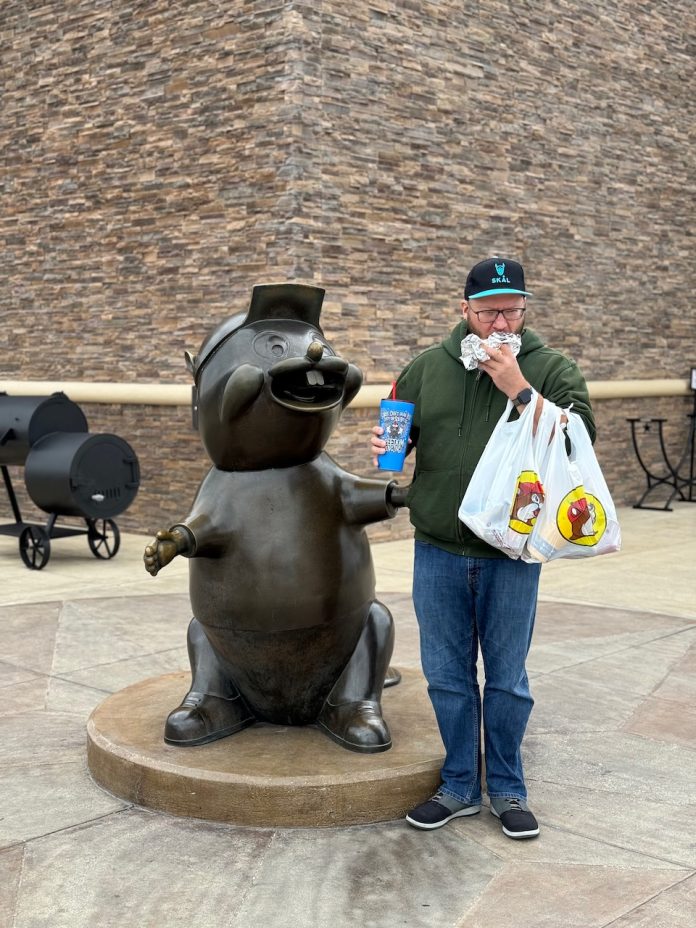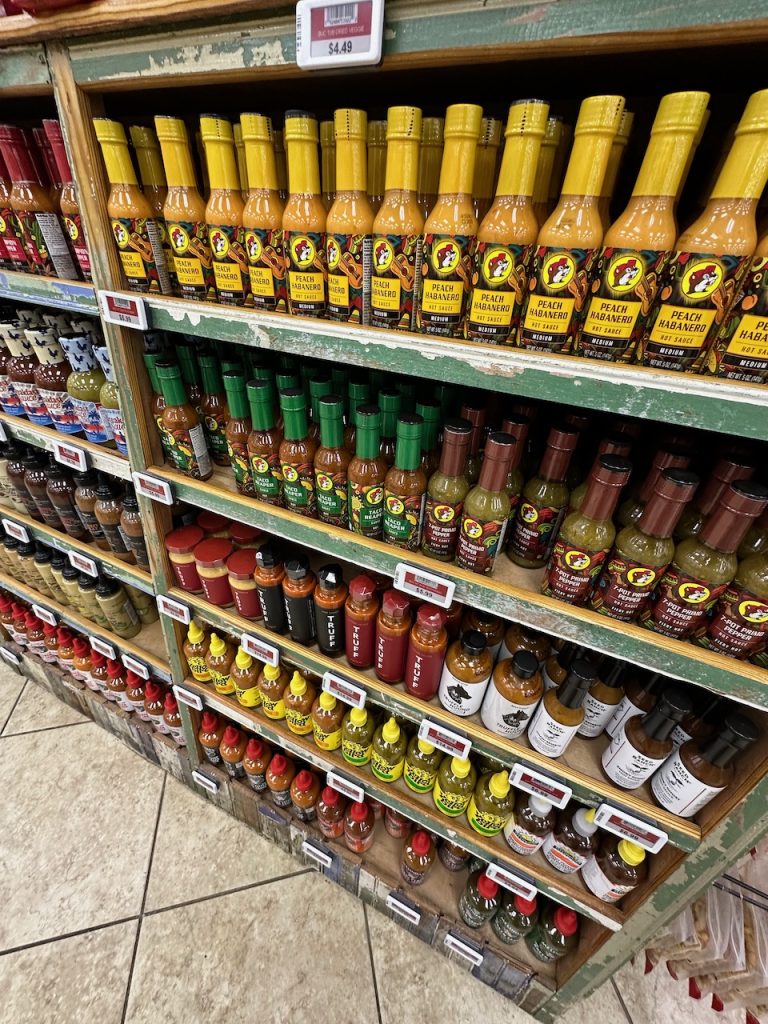The 15-Minute City can’t contain this Texas-sized powerhouse.
The golden beacon draws in weary travelers from the nearby interstate. With the promise of sustenance, reprieve, and clean bathrooms, the oasis calls passersby. They pull into the parking lot like moths to a light in the darkness. They seek ways to refuel their cars, their bodies, their souls. They amble up to the door with the grinning beaver, and find rest. This is Buc-ee’s, the chain of legendary Texas travel plazas.
Just north of Fort Worth, Buc-ee’s store #37 sits between Interstate 35W and the Texas Motor Speedway. Everything in this area is expansive; warehouses, airports, shopping centers of sizes only exceeded by the distance between neighbors. Each building, moated by tarmac, cuts further into the prairie and adds it to the ever expanding Metroplex.
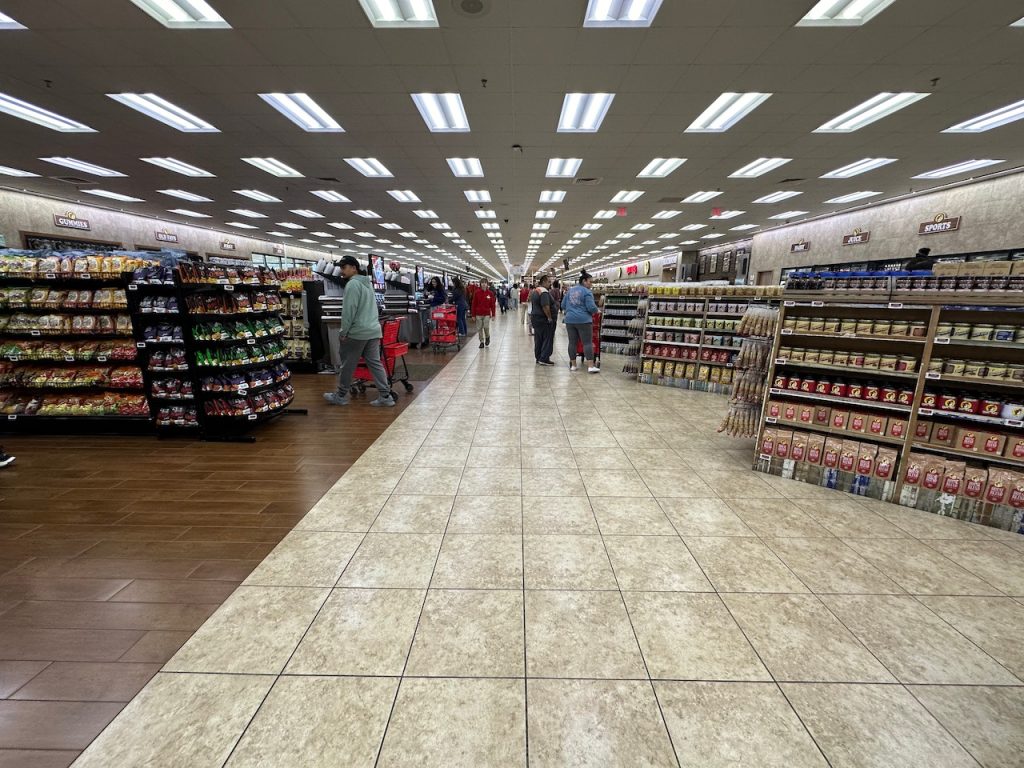
This travel plaza is no different. It is the second exit off the frontage road south of the intersection between I-35W and Texas Route 114. These highways are just two lanes in each direction, four counting frontage roads. But each right-of-way is over 500 feet wide. It’s not that the highways are wide now, it’s that they’re set to be much wider soon.
And Buc-ee’s will be ready. Past the towering, highway-visible welcome sign, one pulls through four bays of gas pumps, each hosting 24 separate filling stations. Both north and south of the building are full rows of parking. It is busy, as people and cars orbit the complex. This is not just a place for gas, but a destination unto itself. But just for cars. Come to find out there is a difference between truck stops and travel plazas. Who knew? Well, start with the truckers that moved everything you bought and ate this past week. They’ve been turned away at Buc-ee’s.
Inside, Buc-ee’s Fort Worth is over 50,000-square-feet of sodas, cast iron skillets, souvenirs, and smoked meats. There are displays of Buc-ee’s merchandise, including plenty of Christmas ornaments in these weeks leading up to the holiday. Full beaver onesies are available for purchase, as are ice chests, wine, and Adirondack chairs. It has four banks of soda stations, including some of the store’s own brand of real cane sugar beverages. There is a deli counter for many types of jerky.
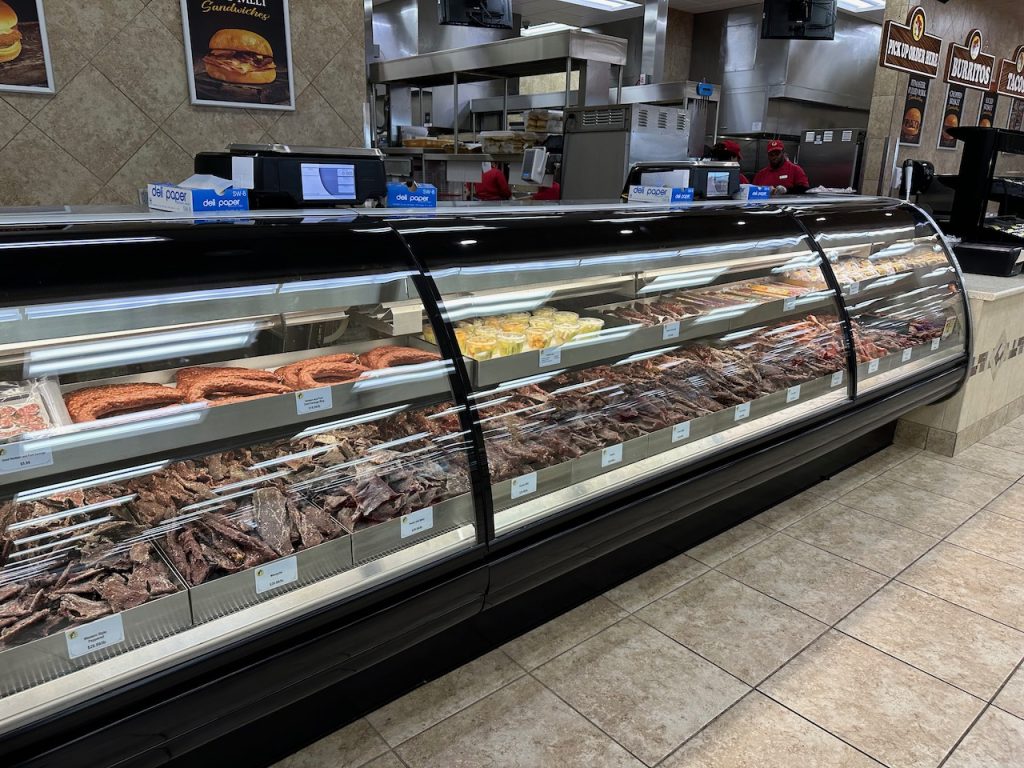
Across 46 active locations throughout Texas and six other, lesser, states, Buc-ee’s deals in superlatives. It has Guinness World Records for the largest convenience store and the longest car wash. Its locations have dozens of gas pumps, if not over 100, and shops of a size that rival nearby grocery stores.
The legend of Buc-ee’s is Texas-sized too. It starts with a family, convenience store owners who decided against shoveling simple junk to travelers from their Louisiana station, but provide them with a notable, remarkable station experience. The youngest scion, one Arch “Beaver” Alpin III, got an idea to translate the family business into something bigger. In 1982, he opened his namesake station outside of Houston. As the chain has spread, its success and devotees have too.
Remember that year, 1982, when you get to Buc-ee’s. It appears on many of the shirts. And pajama pants. And commemorative cups. The store is a testament to not just quality and service, but the power of branding. The mascot beaver, who remains unnamed, extends his recognizable smile to an ever-widening “cult” following.

Half of the store is packed with the tchotchkes recognizable to any highway traveler. There are plenty of faux-hand-painted signs touting the benefits of prayer, wine, or dog ownership. There are shapely mugs and triple fleece blankets. There are outfits covered in sequin colors that exceed the human capacity for sight. There are so many ways to spend a few bucks announcing that you weren’t just at Buc-ee’s, but indeed celebrate the whole of the South and many aspects of Country Living.
The food selection is limited, but not to its detriment. A couple of racks feature the regular convenience store selection of name brand candy and chips. Move past them to where a half dozen of the hardest working guys bustle behind glass in the middle of the store, each sporting a cowboy hat and apron, doing the work of chopping beef for tray after tray of brisket, BBQ and sandwiches.
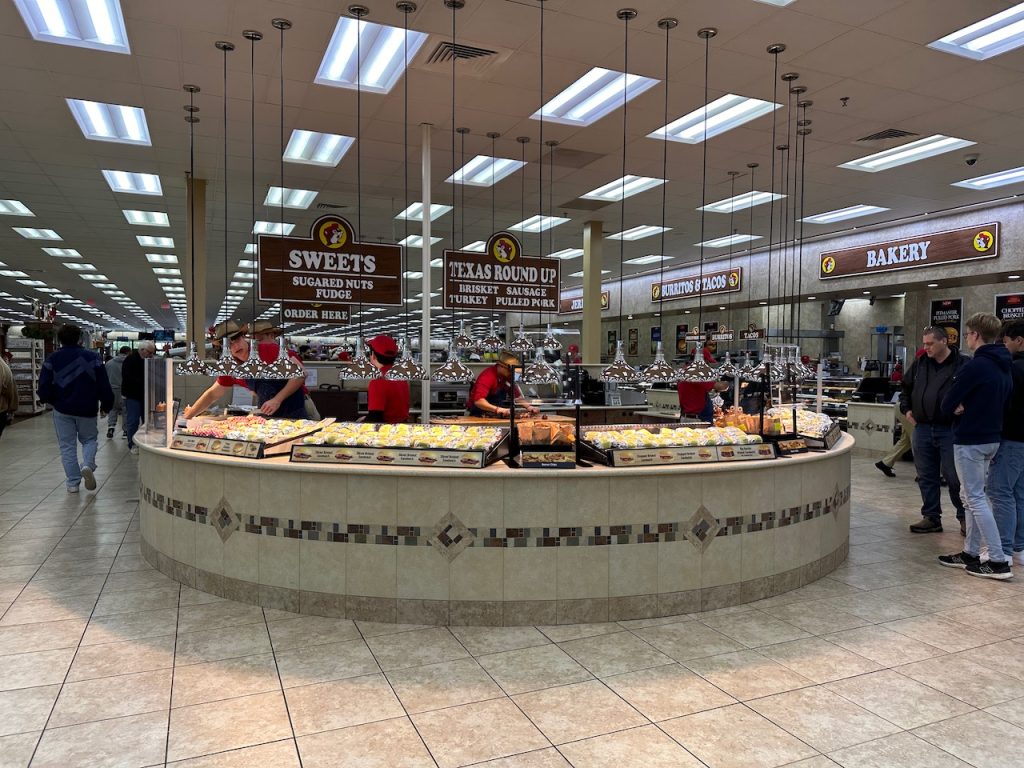
If you get past the call of the live meat action, there are other store-brand treats to behold. Backed up to the meat counter is the counter of handmade fudges and candied nuts. And did I mention the jerky counter? It’s next to banks of soda machines with enough fountain heads to let the indulgent voices get just a little loud. “Mix in another one,” they say. And you do.
What the store lacks in brand names, it makes up for with its own personality. Being a location for drivers of large trucks to congregate, that includes an extensive selection of Buc-ee’s brand hot sauces. And the smiling mascot’s domain extends over snack foods, with the number of variants of the trademark Beaver Nuggets challenging the number of Texas counties. (254, still fewer than the number of zones in Seattle.) To describe these Beaver Nuggets as sweet is like saying The Barbie Movie is pink. Literally, it’s a puffed corn snack, and corn is the second ingredient after sugar.
This is the part where we have to talk bathrooms. And this is the part where we’re obligated to say they’re fantastic. Because they are. Regularly attended, super clean, and enough stations to handle the fact the building has almost a hundred gas pumps and just as many soda fountain dispensers. This is stadium-level capacity with luxury box quality. It’s won awards.
Which is just one reason it kinda sucks that we could never expect to see a Buc-ee’s in the city. Just once, it would be nice to head downtown or to a park without worrying about finding a clean, accessible bathroom.
Sure, mega-gas stations are blights on the landscape, symbols of capitalist excess, and cesspools of climate terrorism. They’re frankly futureless, if we have any hope of keeping the Earth’s atmosphere from bursting into flames, or my belt from bursting holes to the next size up.
But to complain about Buc-ee’s on those levels misses the point. Buc-ee’s is a gas station and convenience store that does a really good job at both because they keep things easy. Easy to find a pump. Easy to find a clean toilet. Easy to get in for a tasty snack, soda, and commemorative cup, then back out on the road.
Urbanists really like to talk about the 15-minute city and density and activation and beautifully built places. There’s so much stuff packed into those ideas that it squishes out the ideas of ease and convenience. Sure, people who have the experience of living in the city can say it’s nice to pick up dinner on the walk home from the bus. Unfortunately, most Americans don’t get a chance to try this because the city is inconvenient, expensive, and intimidating.
We don’t need to find a Buc-ee’s on every corner, or frankly, any corner downtown. The store’s 17-acre footprint is almost the same as Lumen Field. But urbanists can do well to understand the appeal of friendly convenience. The ideals that make Buc-ee’s popular shouldn’t be poo-pooed by people who love the city, just because the shop sells Gadsden Flag insulated mugs. Tossing convenience aside — even when it comes with a 30oz soda and BBQ sandwich — it’s easy to forget that clean and friendly is nice, even for city dwellers who can’t tell their brisket from their pork butt.
Clarification: We’ve come to find out there is a difference between truck stops and travel plazas. Who knew? Well, start with the truckers that moved everything you bought and ate this past week. Apparently, commercial trucks are not allowed to park at Buc-ee’s, which has not ingratiated them with the trucking community. Do not take the “truck stop” headline literally. Buc-ee’s is a travel plaza only.
Ray Dubicki is a stay-at-home dad and parent-on-call for taking care of general school and neighborhood tasks around Ballard. This lets him see how urbanism works (or doesn’t) during the hours most people are locked in their office. He is an attorney and urbanist by training, with soup-to-nuts planning experience from code enforcement to university development to writing zoning ordinances. He enjoys using PowerPoint, but only because it’s no longer a weekly obligation.


